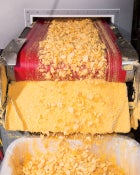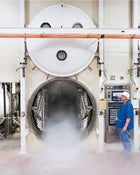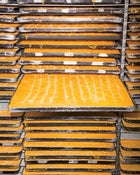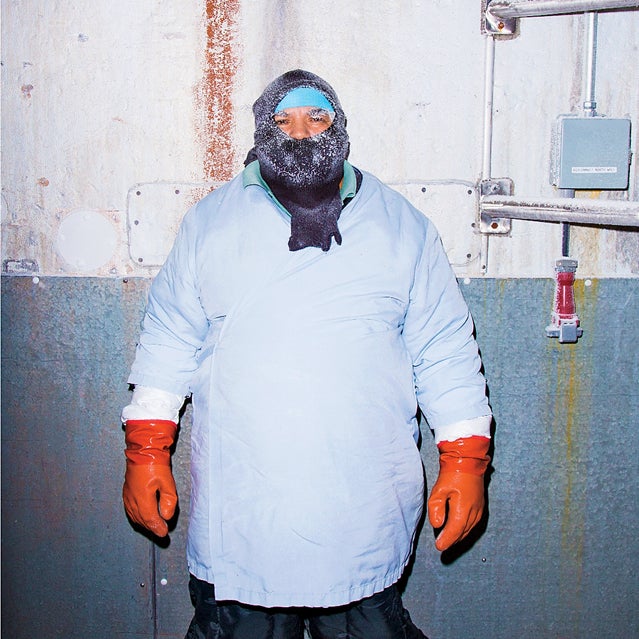We're living in the era of artisanal food. Everything that’s good is supposed to be organic and small-batch and preferably produced by a Manhattan refugee who left a high-stress job to make cheese on a Vermont farm where the cows sleep on hypoallergenic mattresses and are raised on a diet of Tibetan poetry and free-range alfalfa. In my own carnivorous way, I’m guilty of this same gastronomic high-mindedness. I once spent 10 days wandering the Patagonian countryside in search of the perfect grass-fed steak, and I’ve engaged in the questionable practice of breeding pigeons in my basement in order to replicate the early-20th-century squab recipes of French master chef Auguste Escoffier. I also host a TV show on the in which I travel to remote locations to hunt for, cook, and eat wild game, often within feet of where it fell. But despite all my food-based travels, which have resulted in many sublime dining experiences, I have something to admit: many of my most memorable meals have been slurped from seven-ply laminated sacks of factory-produced freeze-dried food resurrected from its mummified state with an application of boiled pond water and usually a few dribbles from the end of my runny nose.
 Freeze-dried mach and cheese ready for the trays.
Freeze-dried mach and cheese ready for the trays. Food is funnelled down onto trays in the Oregon Freeze Dry factory.
Food is funnelled down onto trays in the Oregon Freeze Dry factory. A vacuum chamber being defrosted.
A vacuum chamber being defrosted. The final product.
The final product.I like to brag that I’ve eaten more freeze-dried food than any man living, which is probably a lie. What isn’t a lie is that I’ve enjoyed every nibble, thanks to the mind-blowing ambience of the rugged places where I eat it. Take a recent day hunting mule deer in Montana, when I came stumbling down from a snowbound butte after 12 hours of nothing but energy-gel shots so hungry that I was sucking on the palm of my glove to extract the leathery flavor. Back at camp, I dug through my gear and found a bag of Mountain House spaghetti with meat sauce that I’d bought at a Walmart six months earlier and 2,000 miles away. The packet had been living alternately in my gear closet, my car, my duffel, the floor of a canoe, the inside of a tent, and, for the last 20 miles, the bottom of my backpack. It was all my frozen fingers could do to fire a Jetboil to melt some snow. I added the boiling water and voilà. It certainly beat the campfire omelet my buddy would have made if his Nalgene full of cracked eggs hadn’t come open while he was trying to thaw them out in the foot of his sleeping bag. In that moment, I was feeling downright thankful that research scientists had found out how to make a surprisingly delicious food item that had spent some 20 hours inside an industrial sublimation chamber at temperatures and pressures equivalent to what you’d find in the mesosphere 40 miles above the Earth’s surface.
MENTION FREEZE-DRIED FOOD to your average American—one whose meals are prepared exclusively in restaurants or home kitchens—and their frame of reference is likely limited to astronaut feed. To their credit, it is as common to space flights as popcorn is to movie theaters. The first meal ever eaten on the surface of the moon, by Neil Armstrong and Buzz Aldrin, included freeze-dried bacon squares and peaches. In fact, every manned mission ever launched by has carried freeze-dried food. NASA’s systems engineers appreciate the same qualities—minimal weight, resistance to spoilage, high nutritional value, and negligible preparation—that have so endeared it to hardcore backcountry enthusiasts.
Despite its space-age connotations, freeze-dried food is one of many developments in man’s ancient quest for the perfect shelf-stable traveling grub. Jerky was probably the earliest manifestation of this desire; you can imagine its discovery happening many times, as early hominids stripped the preserved, air-dried remnants of meat from carcasses left behind by saber-toothed cats. The first Europeans to arrive in the New World were dining on meat and fish preserved in kegs of salt, and they encountered Native Americans who’d made long-lasting trail food by mixing shredded jerky with melted animal fat.
At some point along humanity’s road to modernity, freeze-dried food was likely developed by accident. Ancient Peruvians stored meat and potatoes on the mountaintops above the Incan city of Machu Picchu, where the cold, high-altitude climate was similar to the conditions created inside a modern freeze-drying chamber. While various tinkerers conducted laboratory experiments throughout the late 1800s and early 1900s, the preservation technique didn’t achieve widespread use until World War II. Then, during what was essentially the greatest medical crisis ever experienced by humankind, health professionals began freeze-drying blood plasma and volatile serums such as penicillin that could be shipped overseas without the need for mobile refrigeration.
It wasn’t long before food engineers took note of the emerging technology. By 1963, began using freeze-dried fruit in its breakfast cereals. The next year, today’s largest diversified manufacturer of freeze-dried goods, , which makes —the brand most aficionados of freeze-dried meals consider the best—opened its first plant in western Oregon. One of the company’s initial contracts was with the U.S. military. Special-operations units in Vietnam were suffering hindered mobility in the jungles due to the cumbersome, wet-packed C rations developed for World War II.
The answer to this dilemma was the Long Range Patrol ration, dubbed the LRP ration by troops. It was an 11-ounce pack containing accessories such as shrink-wrapped gum, instant coffee, and cigarettes, plus a 1,000-calorie entrée of standard American table fare—chicken and rice, spaghetti with meat sauce, chili con carne—packed inside a waterproof, olive drab envelope. Soldiers liked the LRPs because they could carry a meal in the hip pocket of their fatigues. By 1967, Oregon Freeze Dry had delivered more than nine million such meals to the military.
After reading a November 13, 1967, Newsweek article about LRP rations, REI founder Lloyd Anderson sent a personal letter to Oregon Freeze Dry congratulating it on the success of its new products and asking for a price list. By the time Oregon Freeze Dry launched its first retail product line in 1969, called Tea Kettle, American outdoor enthusiasts had already discovered the company’s military offerings through stateside Army-surplus outlets.
Today, Mountain House is the most widely available brand produced by any of the four major freeze-drying manufacturers operating in the U.S. And while Oregon Freeze Dry still maintains lucrative government contracts with NASA suppliers as well as U.S. military forces, the consumer market has steadily increased. Mountain House now accounts for 40 percent of the company’s total business. Annually, it sells 20 million servings, 10 million of which are purchased by outdoor recreationalists.
Oregon Freeze Dry’s head of marketing anticipates consumer purchasing to keep rising, thanks to the growing population of preppers. From families in Florida bracing for hurricanes to survivalists in Idaho gearing up for the apocalypse, preppers now account for roughly 50 percent of Mountain House sales—up from just 7 percent a decade ago. Faced with economic and climatic uncertainties, more and more people are discovering something that outdoor adventurers have known for a long time: when times get tough, it’s nice to know you’ve got a stash of indestructible food within easy reach.
WHEN MY BUDDIES AND I are hunkered under a tent vestibule eating freeze-dried food, the conversation often turns to our favorite brands. My friend Remi is fond of , a Boulder, Colorado, company that uses aggressive seasoning blends in its formulas. Mountain House is my go-to label. I’m a huge fan of its chili mac and sweet and sour pork, and I actually fell into a brief depression recently when it canceled another favorite, chicken Polynesian.
In the interest of becoming a more erudite camping partner, I paid a visit one day to the headquarters of Oregon Freeze Dry in Albany, Oregon. Today, the company employs almost 400 people, and its corporate offices are on a parklike campus with manicured groves of birch trees. The main office building is shaped like the letter M that adorns the packaging of Mountain House products. The production facility is a short distance away across a set of railroad tracks.
On the day I toured the facility with John Damon, the senior vice president of manufacturing, it was running a batch of spaghetti with meat sauce. The company prides itself on the fact that its food is first prepared as a ready-to-eat dish before it is freeze-dried, which leads to what it calls the “homemade taste” of its offerings. The magic begins in the cook room, where ingredients ranging from shrimp and vine-ripened tomatoes to parsley and precooked ground beef are combined to make the approximately 27 products that Mountain House offers at any given time.
In the case of spaghetti with meat sauce, the dried noodles are boiled and added to a pasta sauce made on-site from spices, tomato paste, and ground beef. The food is cooked in hog-size kettles that can hold 1,200 pounds, then poured through a funnel into a hopper located on the floor below the cook room. There, still-warm spaghetti is spread into inch-deep layers on shallow, rectangular trays resembling cafeteria pizza pans. The dishes go into a subzero freezer as big as a school gymnasium. The exact temperature of the room is proprietary, determining the size and shape of the ice crystals that form as the food freezes.
The actual freeze-drying comes next. The doors of the 18 freeze-drying chambers are round and fortified, like portholes. Each chamber is big enough that you could park a couple of four-wheeler trucks inside of it and can accommodate 4,800 pounds of the spaghetti, still frozen in trays and loaded onto rolling racks. Once the doors are sealed, overhead pumps are engaged and, as Damon says, “we pull a vacuum on it.” As the air pressure inside the chamber decreases to about 1/10,000th of what you experience at sea level, the temperature drops to minus 50 degrees Fahrenheit. Then, slowly, the racks holding the trays began to radiate warmth. As the temperature of the frozen water inside the food increases, the molecules sublimate—that is, they skip the liquid state and go directly from frozen to gaseous form. The free-floating vapor, liberated from the spaghetti, collects again as ice on supercooled coils arrayed on the walls of the chamber.
By the end of the process, about 20 hours later, the coils have collected more than 400 gallons of water. The spaghetti will come out weighing about 1,400 pounds. The outward appearance of the food is essentially unaltered, and its nutritional content is identical to what it was before going into the chamber. (The difference is that you can lift a tray’s worth of spaghetti like a Frisbee and fling it at a wall.) It is then crushed into gravel-size chunks and put in laminated bags made of polyester, aluminum, and nylon. The most common bag size holds 4.5 ounces of freeze-dried spaghetti, equivalent to 2.5 servings. Each serving has 220 calories, 5 grams of fat, 11 grams of protein, and a bit more salt than you’d find in a Quarter Pounder but half of what you’d get from eating the same thing at Olive Garden. (The company has launched several low-sodium entrées and will be releasing more.) The filled laminated bags are purged of oxygen using a small amount of iron. As long as the package isn’t punctured—and it is very hard to pierce—the spaghetti has a shelf life of at least 30 years.
FREEZE-DRIED FOOD HAS its critics, and they go beyond your typical culinary pantywaist who refuses to suck it up and eat what’s put in front of him. Some of my most trusted travel companions have lodged complaints against the stuff, few of which have to do with the taste. A producer of my TV show named Dan Doty, whom I’ve traveled extensively with in the outdoors, has observed that the serving pouches are generally deeper than your average spoon is long. You can’t get the food out of the bottom without getting slop all over the handle, a particularly vexing problem when it comes to the epoxy-like cheese in freeze-dried lasagna. Other complaints are more biological. My director, Morgan Fallon, protests that freeze-dried food contains so much salt that his fingers swell up like boiled hot dogs when he’s been eating it for a few days. Another friend, Bryan Callen, an actor, says that a few days’ worth causes his bowel movements to veer wildly from voluminous diarrhea to teaspoons of plasticine.
These complaints actually serve as testaments to the overall quality of freeze-dried food. Each was groaned by a person who was actively cramming his face with a bag of the stuff while traveling by foot or canoe in places like New Zealand’s South Island, northern Alaska, and backcountry Montana. The complainers are similar to people who bitch about commercial airlines; sure, there’s hardly room for your legs, but the flights don’t suck nearly as bad as staying home does.
My friends’ observations are more or less particular to the long-term consumption of freeze-dried food, something that only a small and peculiar segment of the population engages in. For a more general perspective, I had a bunch of non-camping food enthusiasts over to my house one night for a freeze-dried dinner party. Among several others, I invited Chris Collins, the long-time executive producer of Anthony Bourdain’s ; Alberto Gonzalez, the owner of , the first certified-organic restaurant in New York City; Benjamin Wallace, a bestselling food and wine writer; Savannah Ashour, a food writer and book editor who has worked on many cooking titles; and Manhattan chef Matthew Weingarten.
It was the easiest dinner party I ever put together. I pedaled my bike to REI and bought 9,860 calories worth of food weighing a total of nine pounds for just under $100. All of this fit into a laptop backpack described by its manufacturer as “svelte.” Then I rode home and filled a teakettle with water and laid out some spoons. I was ready to roll. My wife, Katie, still felt that something was missing. She set out a tablecloth and plates, creating a weird incongruity: freeze-dried food on wedding china.
I started with two ethnic dishes produced by Backpacker’s Pantry, which uses both freeze-dried and dehydrated ingredients. The CEO of Backpacker’s Pantry, Rodney Smith, explained to me that his company’s motto is “having fun with your food.” The style might best be understood as an experimental and highfalutin’ answer to Mountain House’s admittedly conservative approach. Sadly, while Backpacker’s Pantry has many fans, especially of its Hawaiian chicken and Louisiana red beans and rice, the ethnic dishes didn’t fare so well. On the subject of the pad Thai, Ashour, the book editor, had this to say: “That has nothing to do with pad Thai.” I noted that the curry tasted like a two-year-old had gone wild with the contents of a spice cabinet. Another participant noted that the odor of the curry resembled a cleaning product. Weingarten observed that his wife makes worse curry. “Don’t print that,” he quickly added.
With the ethnic dishes, my friends had hit upon an opinion that I’ve long held about freeze-dried food. Enjoying it comes down to one’s ability to manage expectations. In our minds, at least here in the U.S., pad Thai is represented by the superb preparations that we’ve come to expect from Thai restaurants. Compared with such an ideal, any just-add-water dish is going to disappoint. As Gonzalez, the restaurant owner, put it, “I was looking for something I didn’t find.” This helps support what I consider to be the genius of Mountain House. In a way, the typical Red State table fare it offers is a way of saving you from yourself. The menu is openly honest about the limits of the technology. It’s the company’s way of saying, “Trust us, dude, just go with the beef stew. Let’s not get carried away.”
This theory was given further support when I switched gears again and served up a few sacks of Mountain House beef stew followed by spaghetti with meat sauce. Peering into the bag, the chef observed the similarity between its contents and “something I ate as a kid, like at a mean babysitter’s house.” After tasting it, he remarked that it was actually way better than he thought it would be. The spaghetti, dumped onto plates, resembled a $2 offering from Chef Boyardee. Collins, the producer, said that he’d eaten a lot of SpaghettiOs as a kid—“but this is way better. The noodles don’t taste like they’ve been wasting away in the sauce for months on end.” “This is as good as anything from a can,” replied Weingarten. “Which I mean as a compliment.”
Going into that dinner party, I was aware that it wasn’t necessarily a fair playing field for freeze-dried food. After all, these were people who routinely eat the finest food the world has to offer. And they weren’t suffering from cold or hunger or exhaustion or any of the other things that help freeze-dried food taste as good as it does when you’re out in the middle of nowhere. But still, Collins offered a more eloquent perspective than I’d ever heard from a backpacker or mountaineer. “I’ve had so much bad food around the world, in so many places, that my baseline is different,” he said. “For me, fermented shark in Iceland is bad; it’s like cotton balls soaked in formaldehyde. After eating that, freeze-dried anything is going to be a treat.”
Collins’ perspective was similar to something I’ve always believed. When you’re out in the wild, you should live so fully and recklessly that you’re happy to be alive and healthy by the end of the day. You should push yourself to the point where you can rejoice in the fact that you’ve got a warm sack of bland food in one hand, a spoon in the other, plus a mouth full of teeth. After all, things could be way worse.
Contributing editor is the author of .


